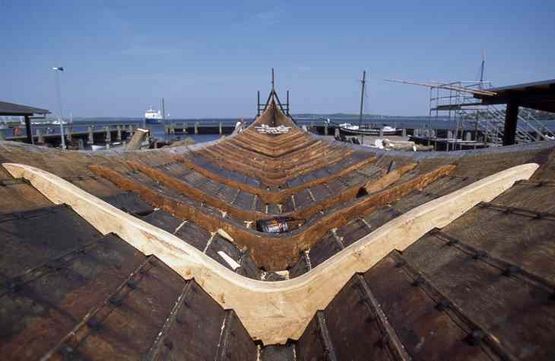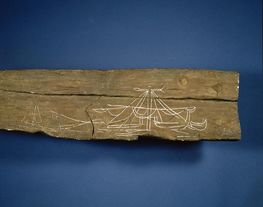The Vikings did not build their ships according to drawn plans, but made use of experience handed down from generation to generation and also of local traditions. There are today many different sources concerning Viking ship building. One of the most famous is the Bayeux Tapestry, on which there is a scene showing William the Conqueror ordering the building of his fleet. Many of the craft techniques, which were used at that time, were later lost and had to be rediscovered when wishing, for example, to reconstruct a ship like the Sea Stallion. The expedition to Dublin in 2007 is therefore also a test of the Sea Stallion. The information gathered during the voyage will form the basis for a greater insight into Viking ship building.
- Which sources do we have concerning Viking ship-building traditions?
- How was the building of a large warship organised?
- Which craftsmen were involved and which materials were used for the ship?
- What is the Sea Stallion painted with and which materials were used for the ship?
- What differences are there between the building of a ship in Viking times and the reconstruction of the Sea Stallion today.
- Which parts of the ship are mentioned most often in the boatswain’s diary from the Dublin expedition and why?
- Is it possible on the basis of the boatswain’s diary to conclude the extent to which the reconstruction of the 30 metre long warship has been a success? Was it necessary to carry out adjustments and repairs during the voyage.
- Is it possible on the basis of the boatswain’s diary to conclude anything about the strength of the ship?
- Draw and colour your own ship. Perhaps you could find inspiration in pictures and films on this website or look at the Vikings’ own pictures of ships – on the Bayeux Tapestry, coins, picture stones etc. If you are good with your hands you can try to carry out the same exercise with a wooden model.
- In Dublin, a ship’s plank has been found on which the image of a ship had been scratched. Make your own plank with a ship motif. Fasten a plank (perhaps one you have made yourself) in a vice and carve out the motif using a chisel (c. 5 mm). The outline of the ship can be painted in to make them clearer. The motif could also be cut into a piece of lino and used for printing.
Ship building
This exercise contains problems, suggestions for practical activities and the worksheet Viking colours.
The exercise deals with topics such as:
- Ship building in the Viking Age
- Sources for the Viking Age
- The Vikings' colours
- The Sea Stallion then and now
- The Sea Stallion – an experimental-archaeological project
The following subjects, places and logs may help in solving the exercise:
The ship's news from the expedition to Dublin 2007/2008 may also provide inspiration.
This exercise can be used for all ages – by setting appropriate questions and activities.
A project on experimental archaeology and the sources of information about ship building in the Viking Age is an obvious way of adopting a problem-oriented approach to studies of the past, especially for the ages 15-20. Parts of the exercises about Sailing and The square sail can also be linked in with this project. The data collected in the logs and the experiences recorded from the expedition enable the pupils to evaluate whether the reconstruction of Skuldelev 2 is a success. They can also assess the information the vessel can reveal about ship building and society in the Viking Age.
For the ages 10-15 a project on the ship's construction, materials, craftsmen, rigging and decoration can be supplemented with some of the practical activities. Questions about sources on ship building in the Viking Age can easily be included here.
Subjects: Science and technology, Woodwork, History, General Studies.
Suitable for age: 10-20 years.
Tools
- Farver UK.pdf
- Viking Age colours

